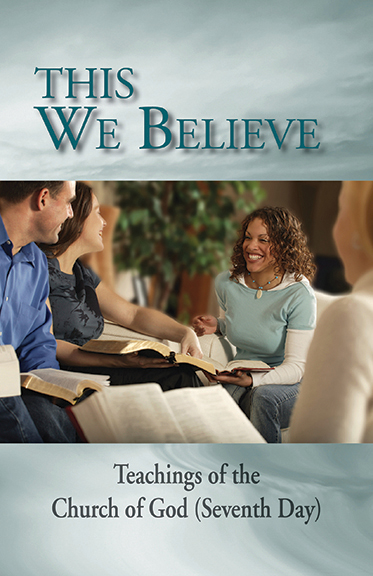Statement of Faith 5
The Church
This we believe:
The church of God in Scripture is a spiritual body of believers who hold the faith of Jesus and keep the commandments of God. Under the lordship of Christ and the authority of His Word, the church exists universally and locally for purposes of worshipping God, preaching the gospel, nurturing believers, and serving humanity. Christians should participate in the church’s mission by service to others and fellowship with believers.
The word in the Greek text that stands behind church in our English versions is ecclesia. It is a combination of two Greek words ek (“out of”) and kaleo (“called”). Thus ecclesia, or church, means simply “called-out ones.”
Translators of the New Testament into English chose the words church or assembly when they read the word ecclesia in the Greek text. Ecclesia can refer to a secular gathering of called-out people, as in Acts 19:32. Of its 118 occurrences, however, it most often describes a gathering of God’s people for worship and fellowship.
As a working definition for our purpose, we may say that the church is an assembly of persons who have been called out of the world by the doctrine of the gospel to worship the true God in Jesus Christ, according to His Word.
Origin and history
The idea of ecclesia precedes both the word and the Greeks who used it. It originated with God himself. Taking the initiative, He fellowshipped with Adam and Eve (Genesis 3:8ff).
In the Greek translation of the Old Testament (the Septuagint), ecclesia is the word used for the English assembly or congregation. This ecclesia of God’s people is referred to nearly seventy times from Genesis through Malachi, as God met with Israel and the saints of old. Examples include meeting to receive the Ten Commandments (Deuteronomy 9:10), to dedicate the temple (1 Kings 8:65), and to hear Ezra read the book of the law (Nehemiah 8:1-3).
The church takes on its New Testament form and function in the book of Acts. There it is reborn by the Holy Spirit’s infusion on the Day of Pentecost, nurtured and edified by the continued work of the Spirit, opposed and persecuted by enemies (both religious and secular), and edified and increased by the grace of its Lord. . . .
Metaphors of the church
The New Testament often compares the church to a body, a building, and a bride.
The church is like a body (Romans 12:5; 1 Corinthians 12:12-27; Ephesians 1:23; 4:12; Colossians 1:24; 2:19). This comparison accents the role of Jesus Christ as the head of all Christians, the assortment of roles that various members play within the one body, and the importance of mutual care and interaction of all members with each other.
The church is like a building (Matthew 16:18; 1 Corinthians 3:13-17; Ephesians 2:19-22; and 1 Peter 2:5-8). This metaphor presents Jesus Christ as the foundation and chief cornerstone, the apostles and prophets as foundation stones, and all the members as living stones used to build up a holy temple to the Lord.
The church is like a bride (Ephesians 5:22-32; Revelation 19:7). In this comparison, the devotion and sacrificial love of Christ for God’s people is stressed, as well as their submission and respect for the one who laid down His life for them.
The Bible uses many terms to describe God’s people. Peter, for example, gives this impressive list: “a chosen generation, a royal priesthood, an holy nation, a peculiar people” (1 Peter 2:9). Other descriptors include the redeemed, the saved, the elect, children of God, Christians, the faithful, believers, saints, servants, and brethren.
The concept of church incorporates all of these. It identifies the spiritual body of believers God has called out of sin and into His family through His Son Jesus Christ. Or, as Peter says in the same verse, “that ye should shew forth the praises of him who hath called you out of darkness into his marvellous light.”
Members of God’s church are compared to . . .
- sheep (John 10:1-18) – They know the Shepherd’s voice and they follow Him.
- branches (John 15:1-8) – By their connection to and dependence on the vine, they bear much fruit.
- stones (Ephesians 2:19-22; 1 Peter 2:5) – Positioned in the building by the blueprints of the Cornerstone, they strengthen the entire structure.
- body parts (1 Corinthians 12:12-27) – For a healthy body, each part depends on and cooperates with all other parts.
These metaphors of the interrelationship between Christ and His church stress how each member is to submit to Christ and cooperate with one another.
Requisites for membership
- Not time or place: God’s people — His church — have existed in every age, wherever men and women, boys and girls, have trusted and obeyed His revealed Word. The church of God has neither chronological nor geographical limitations.
- Not lineage or nationality: John the Baptist warned his audience not to boast of being Abraham’s children (Luke 3:8). The great multitude of Revelation 7:9, 10 includes the saved from every nation. God’s people credit their salvation to God and the Lamb, without regard to gender, ethnic, or national background.
- Not power or position: The apostle Paul says it best: “For you see your calling, brethren, that not many wise according to the flesh, not many mighty, not many noble, are called” (1 Corinthians 1:26, NKJV).
- Not perfect knowledge or flawless conduct: If membership in God’s church were contingent upon having correct knowledge about all matters and proper behavior in all details, then membership could never be certain. A haunting fear that we haven’t known enough or done well enough would always remain.
Each of these, plus all other man-made additions, has served to divide Christians and encourage feelings of superiority and pride, giving false hope. God provided a better criterion for being in His church. Jesus proclaimed, “I am the way, the truth, and the life: no man cometh unto the Father, but by me” (John 14:6; see also Acts 4:12). He also said, By this all will know that you are My disciples, if you have love for one another” (John 13:35, NKJV).
Membership is contingent upon turning toward Jesus as Savior and Lord (faith) and turning away from sins (repentance). That’s how one joins God’s church. New converts are baptized as an outward expression of the inner change already experienced through the Spirit’s work. . . .
Conclusion
The faithful church takes seriously Christ’s commission to go and make disciples of all the weary and scattered masses of people. The church is the place for sinners to find warm, sincere acceptance from Christians who will challenge them to experience forgiveness through the Savior. It is where those coming to Christ will find a family to cherish them and nurture their newfound faith. The church will invite them to serve, provide opportunities for them to discover and utilize God-given abilities and strengths, and be available to fully incorporate and assimilate them into the family of God.
The church is the place for the redeemed to be nurtured into greater Christlikeness. It is where all may receive instruction in truth as the Word is taught and preached. It is where they will be trained to assist in carrying out the Great Commission. In the midst of a thirsty, selfish world, the church is an oasis where acceptance, encouragement, and support are offered and received. In the midst of a tired, busy world, the church is where peace and rest are a blessed reality. In a lonely world, the church offers the rare gift of genuine fellowship.
Scripture quotations are from the King James Version, except where noted.
From pages 61-71
Statement of Faith 6
Christian Ordinances
This we believe:
Christ prescribed two ordinances that confirm faith in Him: 1) water baptism, preceded by a confession of faith in Christ and repentance, represents the believer’s initial union with Christ by depicting death to sin, burial by immersion in water, and rising to a Spirit-controlled life; and 2) Lord’s Supper, a memorial to Christ’s atoning death. Believers commemorate Christ’s death by eating the bread of communion and drinking from its cup, symbols of His broken body and shed blood, thus demonstrating fellowship with our Savior until He returns. It is accompanied by the washing of feet. We observe this Supper annually in the season it was instituted and are charitable toward those who observe it at other times.
Order your own copy of This We Believe at cog7.org/online-store/.







